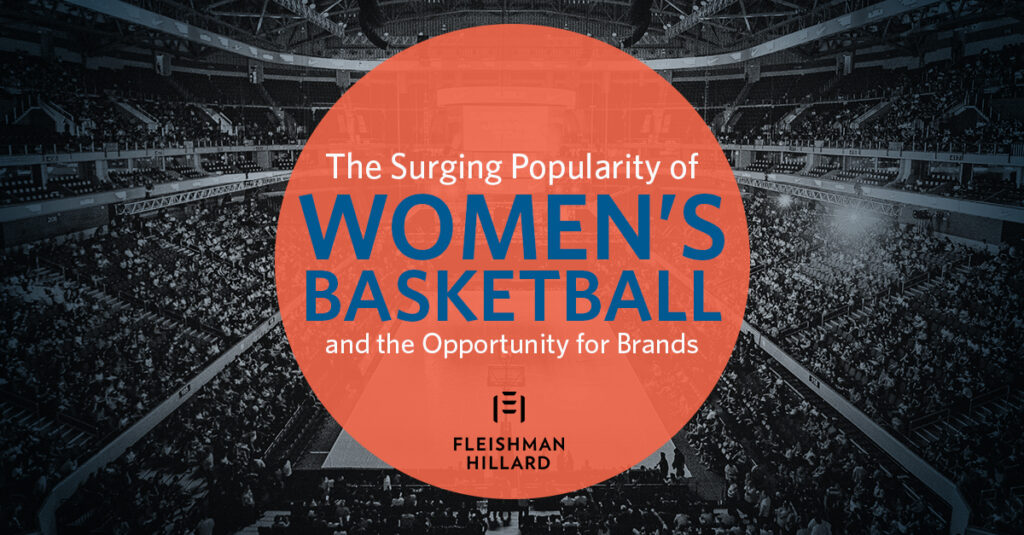The Surging Popularity of Women’s Basketball and the Opportunity for Brands
The NCAA Division 1 Men’s and Women’s Basketball Tournaments bring together casual and serious college basketball fans to cheer on their favorite teams and players, and more often than not, programs and prospects that fans have never had a rooting interest in before. Year after year, the tournaments deliver incredibly compelling storylines. This year’s story, undoubtedly, is the surge in popularity of the women’s game.
Since the tournament’s founding in 1939, the NCAA Division 1 Basketball Tournament has been synonymous with the men’s tournament, and while the men’s game remains extremely popular – there’s been a paradigm shift. For the first time ever, more people watched the women’s championship game than the men’s, according to Nielsen. Additionally, this year’s women’s tournament generated 60% more earned media coverage than the men’s tournament, while also setting viewing records across all six rounds.
The women’s game is taking center stage – with growing popularity and interest in the teams and their all-star rosters – carving out new and exciting marketing and communications opportunities for brands. Now the question is just how big this opportunity will be and which brands will be at the forefront of advancing women’s sports.
We identified three takeaways from this year’s tournament, the trends to watch and the opportunities for next year and beyond.
- Drafting off the Popularity of the Tournament Remains a Winning Proposition: March is often when brands try to attach themselves to the men’s or women’s tournaments to better connect with their target audience. Now, seeing the opportunity to drive visibility and conversation, other organizations are getting in the game, too. During the tournament, it “leaked” that the Big3 offered Caitlin Clark, the University of Iowa’s record-breaking player, $5 million to suit up for the 3-on-3 league – a “historic offer” to a “generational athlete,” according to Ice Cube. The offer generated 1.5K original stories, so don’t be surprised if you see other professional teams or leagues, or upstarts looking to draft off emerging players, leveraging the popularity of the tournament in the future. Brands can get in the game too, as long as there’s an authentic connection to an athlete or another component of the tournament, e.g., team, coach, etc.
- Women Athletes Deliver Proven Value: Watch any sporting event and you’ll see professional athletes during the commercial breaks. But this March – those athletes were predominantly non-professional women athletes. For those brands that wanted to connect with consumers using current college basketball athletes, there were more well-known women superstars in college basketball than men to choose from. That’s particularly evident when reviewing internet search volume for March, where Clark generated 900% more searches than two of the more popular men’s basketball athletes in Zach Edey of Purdue University or Dalton Knect of the University of Tennessee. Moving forward, brands would do well to identify the rising stars in the women’s game – now –, to build their playbook for sponsorships and NIL deals headed into next season. An added benefit of utilizing the top women’s players – they’re staying in college (and at leading schools) longer than their male counterparts, providing a longer runway and better opportunities for brands to curate authentic connections with their growing fanbases.
- Leverage Media with Cultural Influence: One of the more interesting moments during this year’s tournaments was Angel Reese, Louisiana State University’s (LSU) star player, declaring for the WNBA Draft, even though she still had a year of college eligibility left. The interesting part wasn’t that Reese declared for the Draft, it’s HOW she did it – with a feature in Vogue (Angel Reese Is Taking Her Talents to the WNBA). Until now, you may not have put Vogue and women’s college basketball in the same category, but the match-up of Reese’s crossover star power, and the popularity of women athletics, made this exclusive one to remember. The Vogue story delivered significant conversation around Reese’s decision, generating 8.5K earned media stories that continue to drive conversation today, and solidify her position as a budding WNBA superstar. In the article, Reese said of her decision to share the news exclusively with Vogue, “I didn’t want anything to be basic.” Not only was Reese not “basic,” she opened the door for brands to target more culturally focused outlets like Vogue, as opposed to relying solely on sports outlets.
What once was a moment dominated by the men’s tournament has shifted dramatically. Women’s players are the rising superstars, taking their lion’s share of the brand opportunities. With several of the women’s game greats declaring for the Draft, there’s optimism and interest to see how their phenomenon evolves, and who will rise next.
March continues to be one of the greatest times of the year for brands to connect with fans through their shared love of basketball. For those interested in joining the conversation, laying the groundwork for more inclusive partnerships and activations starts now.
Chris Potter, Gabby Hawley, Miranda Xie, Matt Groch and Steve Hickok contributed to this article.

